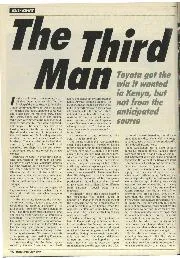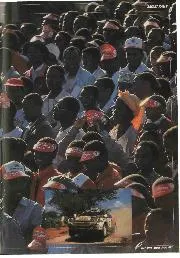

THE THIRD MAN
he Toyota got the win it wanted in Kenya, but not from the anticipated source in the small hours of the morning, a car climbed the ramp in Nairobi after…
ROAD CIRCUITS NATURAL AND ARTIFICIAL
IN WHICH OUR CONTRIBUTOR WEIGHS UP THE PROS AND CONS OF ROAD-RACING CIRCUITS
AMOTORING writer who has attended more motor-races on the Continent than most people, remarked to me recently “I don’t know why it is, but specially built road-circuits never appeal to me as much as the good old circuits on public roads.”
Now I myself have not had the years of experience of the aforesaid individual, who attended many Targa Florios in the days when those words meant something, but even with my limited knowledge of Continental circuits I was bound to agree with him—up to a point.
Perhaps it is unfair to quote the Targa Florio, for that was a race of races, unlike any other, held over a long and mountainous circuit in Sicily. The road was made of flint and gravel, with a notso-smooth surface, and passing was a touch-and-go business amid clouds of dust—when it wasn’t raining, which turned it to mud.
It is a matter of regret to me that I never saw a Targa Florio. Certainly that race had a flavour which could never be possessed or acquired by one on an artificial road-circuit. But to come nearer home, and to circuits that. I and many other motorracing enthusiasts have actually seen. Compare, for example, the artificial roadcircuit at Montlhery with that grand course on the ordinary roads at Reims. I have enjoyed watching races at Montihery, but not nearly so much as I have at
Reims. To begin, with, the circuitrout i er near Paris does not look like a public road, any more than the Melbourne el.-tension at Donington does. And it is not only the road itself that gives this impression, but the surrounding fences, safety banks, and other necessary adjuncts. It is a thrilling sight at Montlhery to see the cars wheeling round the banking and then tearing past the stands into the
beginning of the “road.” But can it compare with the spectacle of the Grand Prix ” bolides ” hurtling down the treefringed straight-leg at Reims, between fields of yellowing corn ?
One can have a drink at Montlhery while the race is on, but it is not the same thing as sitting in a village cafe at Gueux, with the cars passing a few feet away, or in the cafe at Spa alongside the hairpin bend before the stands. That brings us to Spa, another ” natural” circuit which has more atmosphere than many artificial circuits rolled into one. If you are lucky, you can stand behind a hedge (and some straw bales) at Spa and watch the art of high-speed cornering on a perfectly normal country
road. And don’t think that ordinary road circuits are slower than the artificial ones. Both Spa and Reims have been lapped at around the 100 m.p.h. mark. Perhaps the best sight at Spa, however, is that of the silver, red and blue cars streaking up the long hill soon after the start. They can be followed with the eye for a long distance, cutting out momentarily for the natural chicanes of the climb. Nearer home still there is—or was-
Dieppe. Many readers will no doubt remember what a magnificent sight was the start of the last race held there, seen from the cornfields along the straight. Blue, red and green projectiles leapt forward at the fall of the starter’s flag, and hurtled up the long rise with a roar of open exhausts. Somehow the colours always seem brighter on a natural circuit, with the multi-coloured cars, the flags decorating the tribunes, the cornfields, green hedges, and blue sky. Telegraph poles, too, play their part in completing the realism of the scene.
And what of Nurburg Ring ? Well, personally, I would not call this an entirely artificial circuit, although in actual fact it was, of course, built expressly for motor-racing. It is something of a hybrid. The Startplatz, the North Curve, and the run behind the pits are all track, pure and simple, but after that the circuit does become extremely like a real road. What is more, the spectators watch from behind hedges as well as fences, and this gives the road a matured
look. Occasionally one strikes another artificial patch–to say nothing of the weird Karusselkurve–but in the main Nurburg can almost rank with the real natural circuits on public roads. Perhaps the road-signs warning drivers of exceptionally severe corners have something to do with it. Le Mans still retains much of the oldtime atmosphere. Those parts that have been improved, however, wear an artificial appearance that has no appeal for lovers of the natural road-circuit, and this brings us to the advisability of too much
alteration in road-circuits, for example, at Donington. Donington, of course, is another mixture. Much of it looks like it was originally, the drive-ways of a country estate. The beginning of the Starkey Straight,’Ijust after Coppice Corner, is probably the stretch most like an ordinary road, while the new extension, the start, and Red Gate all look artificial. In order to make the course more suitable for high speeds, a good deal of widening is to be carried
out. It would be pleasant if this could be done without making the place look too much like an artificial track. After all this, I would like to say that
fully realise that, logically speaking, it should not matter the slightest whether a course is artificial or natural, so long as it permits good motor-racing to be held on it. Those in favour of artificial circuits have many advantages on their side. Particularly can they argue from the point of view of the safety of the spectators—although I seem to remember that the record number of spectators ever killed by one car stands to the credit or otherwise of Monza, an artificial circuit.
I have said that it should not matter the least whether a course is artificial or not. But on second thoughts I am not so sure. The French people will not hold their Grand Prix at Montlliery ; they prefer Reims. The Italians have given up Monza as a bad job, and now hold their Grand Prix on the public roads at Leghorn. The reason they do so is pounds, shillings and pence—or francs and lire.